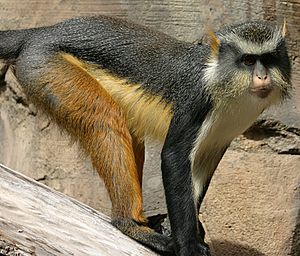Wolf monkey
| Wolf monkey | ||||||||||||
|---|---|---|---|---|---|---|---|---|---|---|---|---|

Wolf monkey |
||||||||||||
| Systematics | ||||||||||||
|
||||||||||||
| Scientific name | ||||||||||||
| Cercopithecus wolfi | ||||||||||||
| A. Meyer , 1891 |
The wolf monkey ( Cercopithecus wolfi ) is a species of primate from the genus of the monkeys ( Cercopithecus ) within the family of the vervet monkeys (Cercopithecidae).
description
Wolf monkeys are among the most colorful representatives of their species. Their fur is colored dark gray on the upper side, the underside is yellow or white. The front legs are black and the rear legs reddish brown, and the rear part of the trunk can also be reddish in color. The face is characterized by a black horizontal stripe from the ears to the eyes and has a whitish-gray, sometimes reddish whiskers. With an average weight of around 4.5 kilograms, the males are significantly heavier than the females with 2.5 kilograms, the head body length varies from 35 to 55 centimeters and the tail can be up to 90 centimeters long.
distribution and habitat
Wolf monkeys live in the central part of Africa , their range is in the Democratic Republic of Congo and incorporates the central Congo basin below the arch of the Congo and it is close to the distribution areas of Bonobo and black crested mangabey match. Their habitat are mainly secondary forests .
Way of life
Wolf monkeys are diurnal tree dwellers that mostly live in the higher layers of the forest. Like all monkeys, they live in harem groups, that is, a male with several females and their offspring. The group size averages ten to twelve animals. They are territorial animals that defend their territory against conspecifics. Sometimes they socialize with red-tailed monkeys or colobus monkeys .
food
These primates are mostly herbivores, but they also occasionally eat insects. Their diet consists mainly of fruits, leaves and seeds, sometimes they also consume nectar.
Reproduction
After a gestation period of around five to six months, the female usually gives birth to a single young. This is suckled for around a year and reaches sexual maturity at two to three years of age. Life expectancy is not exactly known; for closely related species it is around 20 years in the wild and up to 30 years in human care.
Systematics
The wolf monkey is counted among the monkeys in the mona group, within which the species delimitation is controversial. The populations of the wolf monkey north of the Congo River are usually regarded as a dent monkey as a separate species.
The following subspecies are distinguished for the wolf monkey:
- Orange-thigh wolf monkey ( Cercopithecus wolfi ssp. Wolfi )
- Gray-legged wolf monkey ( Cercopithecus wolfi ssp. Elegans )
- Fire-bellied wolf monkey ( Cercopithecus wolfi ssp. Pyrogaster )
Danger
The IUCN lists two of the three subspecies, the nominate form is not considered endangered, whereas the gray-legged wolf monkey ( Cercopithecus wolfi ssp. Elegans ) is classified as potentially endangered.
literature
- Thomas Geissmann : Comparative Primatology. Springer-Verlag, Berlin et al. 2003, ISBN 3-540-43645-6 .
- Don E. Wilson, DeeAnn M. Reeder (Eds.): Mammal Species of the World. A taxonomic and geographic Reference. Johns Hopkins University Press, Baltimore MD 2005, ISBN 0-8018-8221-4 .
Individual evidence
- ↑ a b Thomas Butynski, Jonathan Kingdon and Jan Kalina (eds.): Mammals of Africa Volume II. Primates. Bloomsbury, London, 2013, ISBN 978-1-4081-2252-5 , pp. 333f.
- ↑ https://books.google.de/books?id=6QOzCQAAQBAJ&pg=PA390
- ↑ Cercopithecus wolfi in the Integrated Taxonomic Information System (ITIS)
- ↑ Cercopithecus wolfi ssp. wolfi in the IUCN 2016-1 Red List of Endangered Species . Submitted by: JF Oates, J. Hart, CP Groves, 2008. Retrieved November 6, 2018.
- ↑ Cercopithecus wolfi ssp. elegans in the IUCN 2016-1 Red List of Threatened Species . Submitted by: JF Oates, J. Hart, CP Groves, 2008. Retrieved November 6, 2018.
